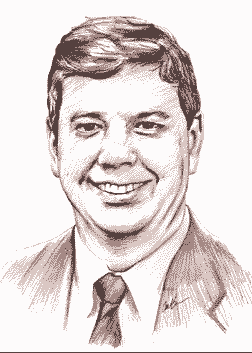INTERVIEW
Trade The Future(s)
Tom Rietz Of Iowa Electronic Markets
by John Sweeney

Iowa Electronic Markets (IEM) are real-money futures markets in which students and professionals trade contracts of everything from US politics to Federal Reserve monetary policy to computer returns. These markets are operated by faculty at the University of Iowa Tippie College of Business as part of its research and teaching mission.
Thomas Rietz, Associate Professor of Finance at the University of Iowa, is an Iowa Electronic Markets manager. Rietz uses a combination of theoretical, empirical, and experimental work to research two primary areas: financial markets and decisions, and elections and voting decisions. He served three terms as the section head for finance on the executive committee of the Economic Science Association, the professional organization for experimental economists. Recently, Rietz was appointed to the interdisciplinary Preferences Network Risk Research Initiative of the MacArthur Foundation.
STOCKS & COMMODITIES Interim Editor John Sweeney interviewed Rietz on November 8, 2000, to find out what Iowa Electronic Markets reveal about politics and trading.
ILLUSTRATION BY CARL GREEN
Our readers are speculative traders, and we've been following the development of academic interest in both technical analysis and behavioral finance. So we're interested in the research that's being done in Iowa Electronic Markets (IEM). Can you give me some information about what your association is with it?
I'm one of the six faculty members at the University of Iowa associated with IEM as a director.
So how did this idea come about?
We started Iowa Electronic Markets in 1988 after Jesse Jackson surprised everybody in the Michigan Presidential primary, because if you had used polls there as a predictive measure, they would have been very inefficient. For a lot of reasons, we believe markets are relatively efficient aggregators of information.
How does it work?
The Iem is set up so you can directly interpret prices as expected outcomes. The market we refer to most of the time, which we call a vote share market, was devised so you can interpret the price as the market's consensus forecast of the vote shares taken by different candidates. It's a direct competitor to polls in terms of predicting an election.
This is distinct from a winner-take-all market?
Yes. The winner-take-all markets are set up with liquidation values determined by the outcome as a zero or one event. You can essentially interpret those prices as probabilities of the outcome. So in this case, the winner-take-all market is designed to predict the probability that one of the candidates takes the majority of the popular vote.
How has that worked in practice?
For the vote share market, I can tell you exactly because after an election, all we have to do is look at the outcome and we can see how far our predictions were from the actual outcome. Now, we've done this in five separate markets on the last four Presidential elections, 14 other markets on other US elections since 1990, and 30 international election markets in the same period. So we've run predictions on a total of 237 different candidates, issues, representatives, houses of parliament, and others around the world. In the Presidential elections we've run, our absolute prediction error has been 1.38%, where the absolute prediction error is measured as the difference between the predicted vote total and the actual vote total.
Does that include this most recent one, the Bush-Gore contest?
Yes. In fact, the last one turned out better than we did in 1996. For our predictions, we typically use the closing prices the night before the election.
That makes sense.
That should incorporate all the information right up to the event but shouldn't allow people who go to vote to come back and trade. In this past election, we were predicting Al Gore not to quite take the majority that he did. The night before, we were predicting George W. Bush would take 52% of the vote.
The way we have this market set up, that means 52% of the total vote that goes to the Republicans, the Democrats, and the Reform party. However, on Sunday night [November 5], we had Gore ahead and he was predicted to take 49.8% relative to Bush's 48.5%. So we were right at the edge, and we had been since the first of May.
For six months, we've been predicting a race that's next to impossible to call. In fact, on the night before the election, we had Bush ahead just by the slimmest of margins, and in fact Gore finished ahead in the popular vote. In this particular three-party race, which is not exactly comparable to the total election outcome but pretty close, we predicted Gore to be 47% and he took 49.9%. We predicted Bush to take 51% and he had 49.7%.
We actually overpredicted Pat Buchanan. We thought he would get 1.6% but he got a little less than 0.5%. That's actually as much an error as anything else.
Our average overall prediction error for all four Presidential elections was 1.37%. Our average this time was 1.96%, based on the numbers according to Cnn. Of course, we'll make any appropriate changes after the recounts are done to determine the liquidation values.
What about Ralph Nader? Did you throw him in there?
No, we didn't, because unless a third party is quite strong, frequently
those votes aren't even reported for that party. So we've chosen to use
10% in several major polls in order to decide when to include someone.
Early in the election, the Reform party was pulling well above that, but
Nader's Green Party never pulled that much in the national polls, so we
never put him in.
So with all that going on, this is a real-money market?
Yes. You can invest anywhere from $5 to $500.
Excerpted from an article originally published in the February 2001 issue of Technical Analysis of STOCKS & COMMODITIES magazine. All rights reserved. © Copyright 2001, Technical Analysis, Inc.